Back in July we wrote about a recent release from Doug Miller and his team at CORE Nutritionals, the CORE Nutritionals X Fun Sweets Cotton Candy Collab!
For those of you who need a reminder, Core PUMP, as its name suggests, is CORE's pump-heavy stimulant-free pre-workout formula. It's loaded with ingredients that trigger vasodilation and improve cellular hydration in order to give your muscles everything they need to look and perform at their absolute best - without the stims.
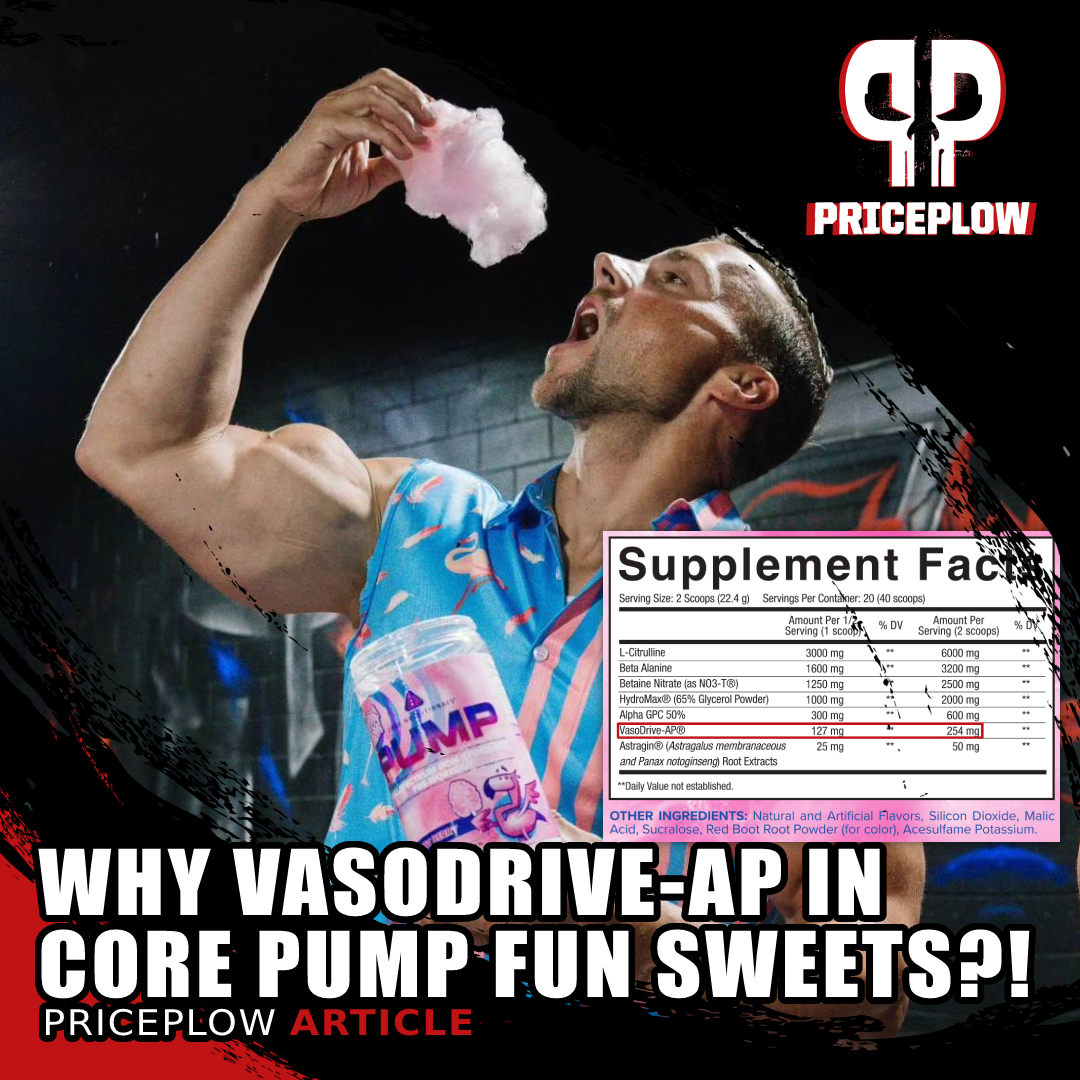
Today, we discuss why Core Nutritionals changed their Core PUMP formula for the Fun Sweets Cotton Candy collab
But for the Fun Sweets edition, a major change was made:
CORE Brought VasoDrive-AP to the Fun Sweets Core PUMP Collab
We've long been following the CORE Nutritionals / Fun Sweets collaboration because of the awesome new cotton candy flavors, Fun Sweets Cherry Berry and Fun Sweets Blue Raspberry. Now that they've been out for a while, we can say with confidence that PricePlow staff and readers alike overwhelmingly love them. They just taste great, and are simply better than other cotton candy flavors on the market.
However, these amazing flavors aren't all that's new in that CORE Pump release.
There was also a subtle formula change in the CORE Pump Fun Sweets release. PeakO2, a mushroom blend designed to improve oxygen utilization and circulation, was replaced by VasoDrive-AP, a blend of milk-derived proteins that trigger vasodilation by a twofold mechanism: first increasing nitric oxide (NO) production and, secondly, decreasing vasoconstriction through ACE inhibition.
This article takes a deeper dive into VasoDrive-AP, why it's great for epic pumps, and why it may just make the Fun Sweets version of Core PUMP the best version if you're looking for all-out pumps.
First, let's check on availability, get you signed up for our CORE Nutritionals news alerts, and then dive into the science:
Core Nutritionals PUMP – Deals and Price Drop Alerts
Get Price Alerts
No spam, no scams.
Disclosure: PricePlow relies on pricing from stores with which we have a business relationship. We work hard to keep pricing current, but you may find a better offer.
Posts are sponsored in part by the retailers and/or brands listed on this page.
This area is reserved for Team PricePlow's upcoming Research Study video.
Subscribe to our channel and sign up for notifications so you catch it when it goes live!
Reason for the Change – Nobody wanted Mushroom Cotton Candy?
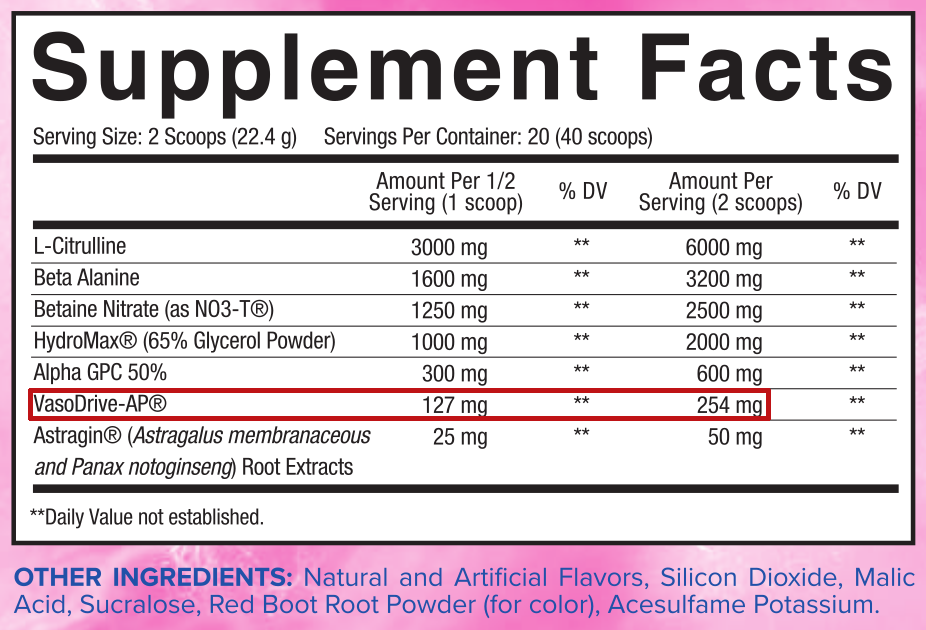
The Core PUMP Fun Sweets Cherry Berry Ingredients, with VasoDrive-AP highlighted. This is the ingredient that replaced PeakO2
There's nothing wrong with PeakO2 from an efficacy standpoint, but it didn't blend well, color well, or taste good enough for the flavors that CORE and Fun Sweets brought to market. This is actually a common challenge with mushroom-based ingredients, but when you think about how PeakO2 works with the specific flavors that CORE and Fun Sweets developed, the change makes intuitive sense.
Fun Sweets is a cotton candy company, so there's a specific flavor and consistency they're going for. VasoDrive-AP consists of milk-derived proteins, and it seems like common sense that dairy products complement cherry and raspberry cotton candy flavors and provide the right consistency for those flavors, better than most edible mushrooms will.
Think about it, mushroom cotton candy doesn't sound that great. But milky cotton candy sounds pretty good.
Let's Talk About VasoDrive-AP
VasoDrive-AP (also sold as AmealPeptide in the general health marketplace) is an ingredient that doesn't get much press – and we're not sure why because, as you'll see, it's an incredible ingredient that deserves more attention.
So what is VasoDrive-AP? It's a combination of two lacto-tripeptides (LTPs) called isoleucine-proline-proline (IPP) and valine-proline-proline (VPP).[1] These proteins naturally occur in the casein fraction of milk protein.
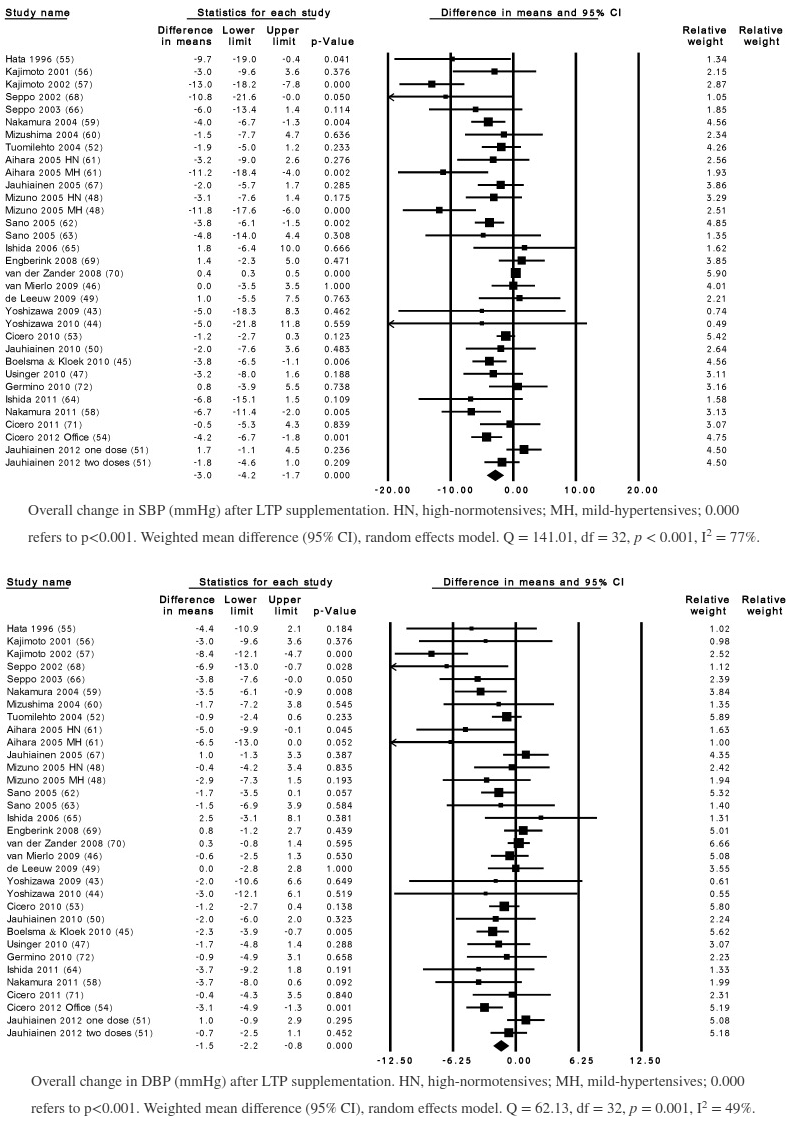
A very thorough meta-analysis of lactotripeptides found in VasoDrive-AP (VPP / Valine-Proline-Proline and IPP / Isoleucine-Proline-Proline) shows consistently significant reduction in blood pressure, both systolic and diastolic.[1]
Like we said earlier, there are two basic mechanisms of action here:
- Nitric oxide (NO) upregulation[1] – leading to vasodilation
- Angiotensin-converting enzyme (ACE) inhibition[1] – preventing vasoconstriction
There are tons of NO boosters out there, the most popular is L-citrulline, which Core PUMP already features a hefty dose of.
However, we rarely see ingredients with documented ACE-inhibition activity show up in sports nutrition supplements. So, it's really the second mechanism that sets VasoDrive-AP apart from competitors and makes it worthy of special attention – especially since ACE inhibition is the mechanism of action behind pharmaceutical blood pressure medications.[2,3]
ACE Inhibition Is A Major Player Behind VasoDrive-AP
As for mechanism No. 1, it's no exaggeration to say that the PricePlow Blog has covered the importance of NO and its role in vasodilation, literally hundreds of times. In fact, if you want to read about NO-mediated vasodilation, we discuss it at length in our article CORE Nutritionals X Fun Sweets Cotton Candy Collab.
We rarely talk about ACE inhibition, though. So let's shine some light on mechanism No. 2, how it works, and why it matters.
The ACE-inhibiting activity of LTPs is not an afterthought. In one meta-analysis that examined nine different studies with 12 randomized controlled trials on LTPs for hypertension, the authors found that all of the studies they reviewed showed clear reductions in blood pressure from LTP intake. And, moreover, every study identified ACE inhibition as the LTPs' primary antihypertensive mechanism of action.[4]
Furthermore, all the studies tested the two specific LTPs that make up VasoDrive: IPP and VPP.[4]
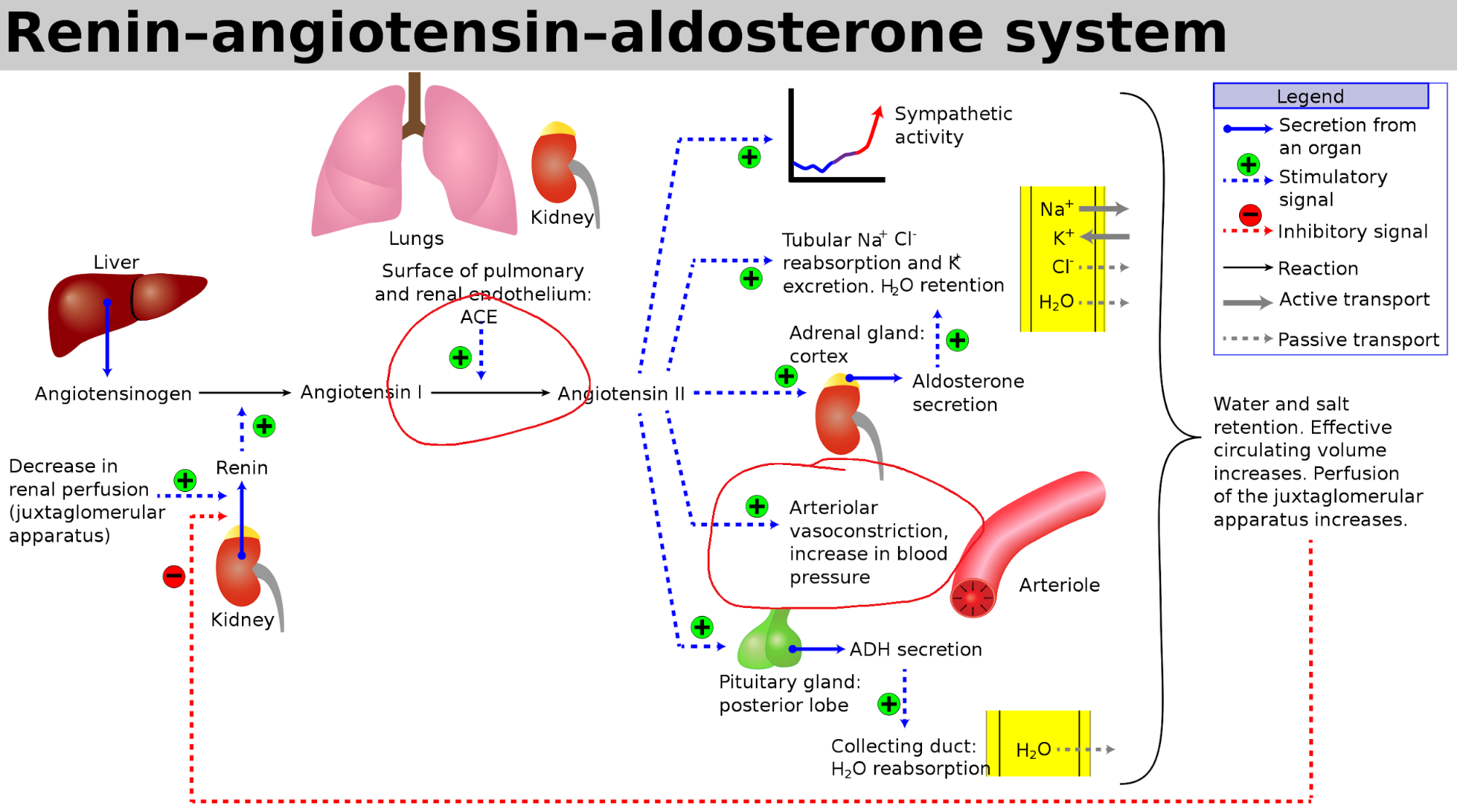
VasoDrive-AP inhibits ACE, the enzyme responsible for converting angiotensin I into angiotensin II. Preventing this conversion also prevents numerous downstream effects, including the rise in blood pressure that ACE2 triggers. The relevant mechanisms are circled in red. (Image courtesy of WikiMedia)
ACE inhibition in a nutshell
The big reason ACE inhibition matters is that converting angiotensin I into angiotensin II triggers the secretion of aldosterone, an adrenal hormone that increases the amount of sodium and water reabsorbed by the kidneys.[5] Since sodium is an osmotic solute, increased sodium and water levels naturally lead to a rise in blood pressure – and, in fact, aldosterone secretion is typically triggered when arterioles in the kidney sense low blood pressure. So, aldosterone is the body's natural mechanism for raising blood pressure when need be.[5]
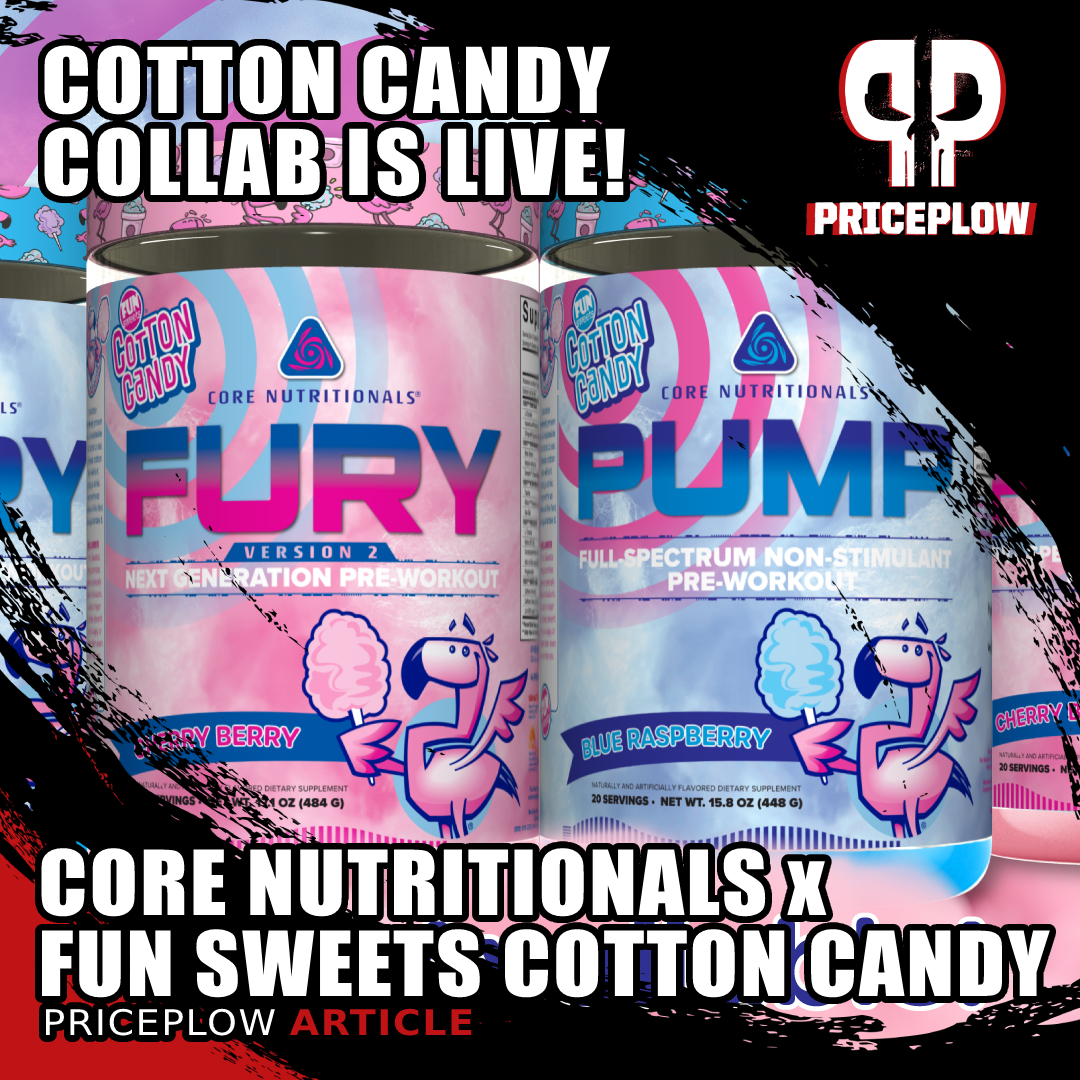
CORE Nutritionals X Fun Sweets is now available!
However, the aldosterone system can become dysregulated and, in that case, high blood pressure is a common result.[5] That's why blood pressure medications typically downregulate aldosterone secretion by inhibiting ACE and preventing the conversion of angiotensin I to angiotensin II.
Why IPP and VPP?
As we mentioned earlier, there are lots of different LTPs. So, why are isoleucine-proline-proline (IPP) and valine-proline-proline (VPP) singled out as the constituents of VasoDrive-AP? The simple and unsurprising answer is that researchers identified both LTPs as the most antihypertensive (or hypotensive, if you prefer).
A 1995 study found that fermenting milk (i.e., creating "sour milk" also known as buttermilk) significantly increased the extent to which it inhibited ACE – and after purifying and isolating the sour milk protein fraction, researchers discovered that IPP and VPP together accounted for 74.4% of the total ACE-inhibiting effect.[6]
The IPP-bradykinin connection
Bradykinin is a complex of peptides that's been shown to cause vasodilation, partly by triggering the release of NO.[7] Since ACE is one of the enzymes responsible for degrading bradykinin,[7] anything that inhibits ACE will naturally raise bradykinin levels.
In other words, protecting bradykinin from being broken down by ACE is a way of preventing vasoconstriction. And that's exactly what IPP does – it's been identified as potent bradykinin agonist.[8,9]
Study – 150 mg/day of VasoDrive-AP Reduces Blood Pressure
Everything we've discussed so far is theory, and while we love to talk theory here at the PricePlow Blog, eventually we need to see some studies that demonstrate what happens when the rubber meets the road.
There are lots of studies out there on generic IPP and VPP (check out the meta-analyses we cited[1,4] if you're interested), but to illustrate what we've been talking about, let's focus on a really compelling AmealPeptide / VasoDrive-AP specific study from 2010.[10]
In this randomized, double-blind, placebo controlled study, 81 patients with stage 1 or stage 2 hypertension received either 150 milligrams of VasoDrive-AP or a placebo daily.[10] All patients, despite having been diagnosed with hypertension, had either forwent treatment or discontinued treatment so long ago that it wouldn't affect the study results. The term used to describe both categories of subject is treatment naive.[10]
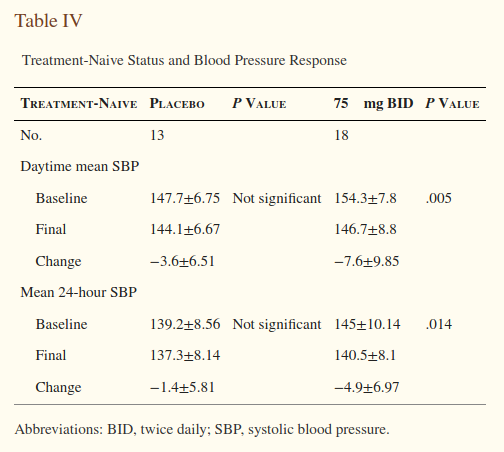
Although both groups saw a reduction in blood pressure, only the VasoDrive-AP group's reduction achieved statistical significance.[10]
The results speak for themselves. The placebo group saw no statistically significant reduction in blood pressure, but the VasoDrive-AP group's systolic blood pressure dropped by 7.6 mm Hg, on average.[10]
That's a remarkable effect size, since even a 5 mm Hg reduction is associated with an impressive 10% lower risk for major cardiovascular events like heart attack and stroke.[11] It's also worth pointing out that a systolic blood pressure of 140 mm Hg, the final average SBP of the VasoDrive-AP group, is widely accepted as the clinical threshold for pharmaceutical intervention.[12] So, many of the people in the VasoDrive group began the study in the pharmaceutical intervention category and ended the study in the non-intervention category.
It's also remarkable to compare this study's results to what we know about pharmaceutical-grade ACE inhibitors. According to a research review on the subject, administering half the maximum dose of the typical ACE inhibitor achieves 90% of its total blood-pressure-lowering effect, which is on the order of 8 mm Hg systolic and 5 mm Hg diastolic.[13]
An 8 mm Hg reduction in systolic blood pressure is very close to the 7.6 mm Hg reduction observed in the VasoDrive study.[10]
Better than L-citrulline for blood pressure reduction?!
Finally, we can compare these metrics against L-citrulline, which has a meta-analysis published stating that "The pooled changes in systolic and diastolic BP were (MD, −4.10 mm Hg; 95% CI [−7.94, -0.26]; p=0.037) and (MD −2.08 mm Hg; 95% CI [−4.32, 0.16]; P=0.069), respectively. The subgroup analysis showed a significant diastolic BP reduction in studies that used doses of ≥6 g/day (MD −2.75 mm Hg; 95% CI [−5.37, -0.12]; p=0.04)".[14]
This means that at far lower doses than L-citrulline (which is generally 6 grams or more), you get greater blood pressure reduction - further impressive for VasoDrive.
VasoDrive-AP, AKA AmealPeptide
It's worth reminding you that the same combination of IPP and VPP is licensed under the name AmealPeptide for applications outside of sports nutrition. AmealPeptide is what's been specifically studied, and the research showed positive results.[10]
One key difference is that AmealPeptide must be licensed for use at 508 milligrams, while VasoDrive-AP can currently be used at lower doses. However, it's the same underlying ingredient.
This brings us to the next question -- dosage -- and why we believe that 508 milligrams (or greater!) makes good sense, and the Core FURY / PUMP stack is on the right track:
VasoDrive-AP Dosage and Questions
One reason we highlighted this particular study is that it seems to establish a minimum effective dose for VasoDrive-AP – the clinical dose is widely regarded to be 508 milligrams, but as you can see, clinically significant effects can actually be achieved at a much lower dose.
So, when you see a dose like 254 milligrams in a pre-workout supplement like Core FURY or Core PUMP Fun Sweets on its own, you can rest assured of its efficacy - it's been successfully studied at 150 milligrams per day![10]
But besides that study, in order to relate VasoDrive to the other research we've seen on VPP and IPP, we have one major question to answer:
How much VPP / IPP is in VasoDrive-AP / AmealPeptide?
The next question is then how much VPP and IPP are in VasoDrive-AP / AmealPeptide?
Reason being, the two meta-analyses on these constituents used far lower doses - see Table 1 of the 2015 meta-analysis,[1] which states "The average dose of LTP was 10.5 mg/day (5.2 mg/day of IPP and 5.3 mg/day of VPP)",[1] or the 2008 meta-analysis which states "Among these trials, the amount of IPP and VPP taken in was 2.6 –5.6 mg/d."[4]
Answer: ≥ 6.7mg / g

AmealPeptide is a one-of-a-kind tripeptide derived from casein protein that improves vasodilation and supports healthy BP levels. It's the same as VasoDrive-AP, but is for non-sports applications and must be dosed at 508mg
We received a recent COA (certificate of analysis) from MayPro Industries, the company distributing VasoDrive-AP, that gives us the answer: VasoDrive-AP is standardized to contain no less than 6.7 milligrams per gram of IPP and VPP combined.
This means that the 254 milligram dose in Core PUMP Fun Sweets yields at least 1.7 milligrams of IPP and VPP, while the Core FURY / PUMP Fun Sweets Stack at 508 milligrams total yields 3.4 milligrams of total IPP/VPP, which gets us into some of the literature cited in the meta analyses above.
Stacking Core PUMP with Core FURY
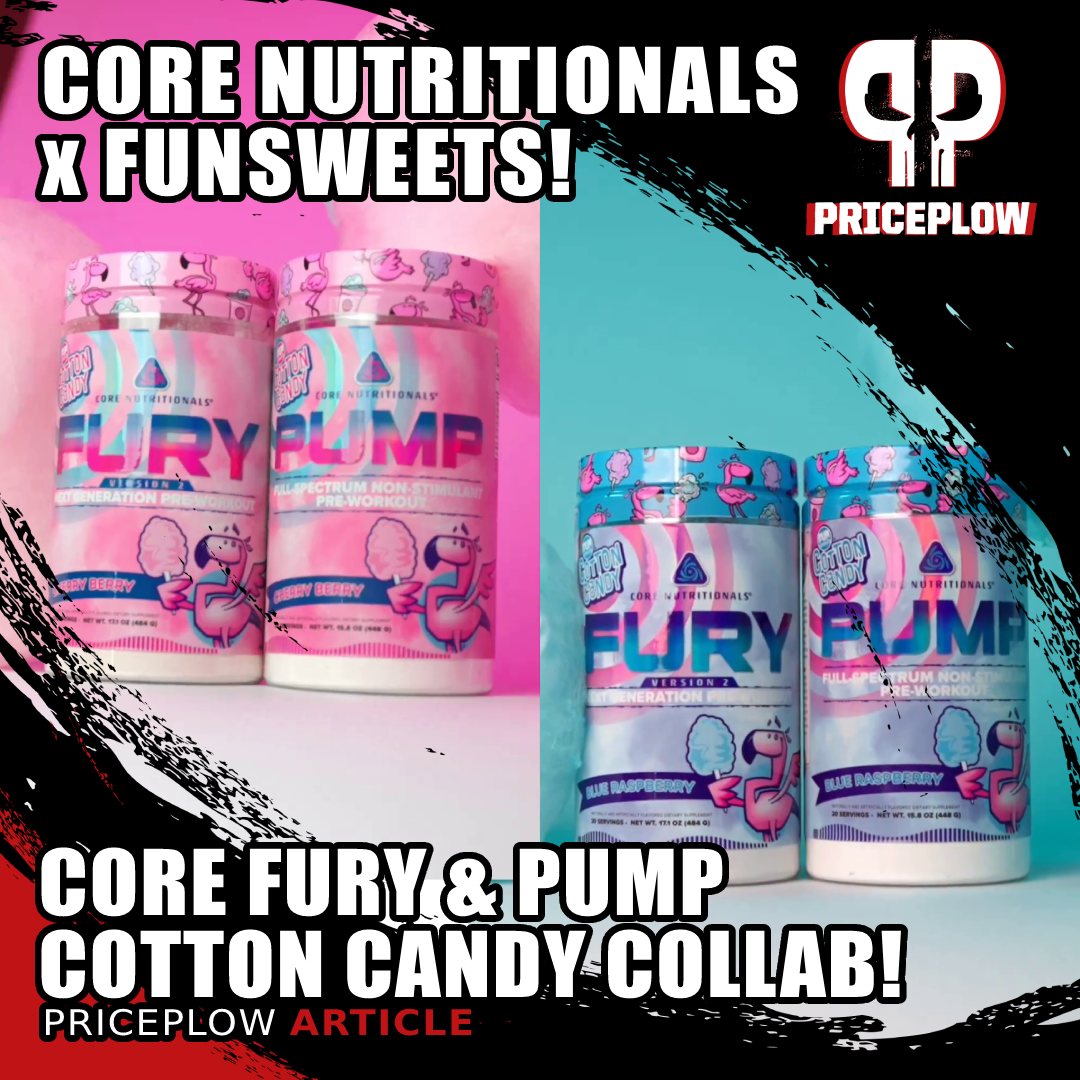
The CORE Fun Sweets Cotton Candy collab is an epic stack, both in flavor and in efficacy. It's available in Cherry Berry and Blue Raspberry cotton candy flavors!
Point being - a serving of Core PUMP with Core FURY is where we really start getting into significant dosing. If you're chasing a solid pump, the total of 508 milligrams VasoDrive-AP is closer to the most commonly used and studied doses of IPP/VPP.
But once again, we've seen clinically significant results at 150 milligrams,[10] so using just one or another is still above statistically significant dosing.
VasoDrive-AP Helps PUMP Live Up to Its Name
As you can see, there's a lot more to VasoDrive-AP than you probably thought. We think this is an ingredient whose time has come and, hopefully, its recent appearance in the Core PUMP Fun Sweets formula will help shine some light on its potential.
One thing is for sure, while PeakO2 has its merits, replacing it with VasoDrive-AP definitely gives users much bigger pumps than the original formula.
Core Nutritionals PUMP – Deals and Price Drop Alerts
Get Price Alerts
No spam, no scams.
Disclosure: PricePlow relies on pricing from stores with which we have a business relationship. We work hard to keep pricing current, but you may find a better offer.
Posts are sponsored in part by the retailers and/or brands listed on this page.
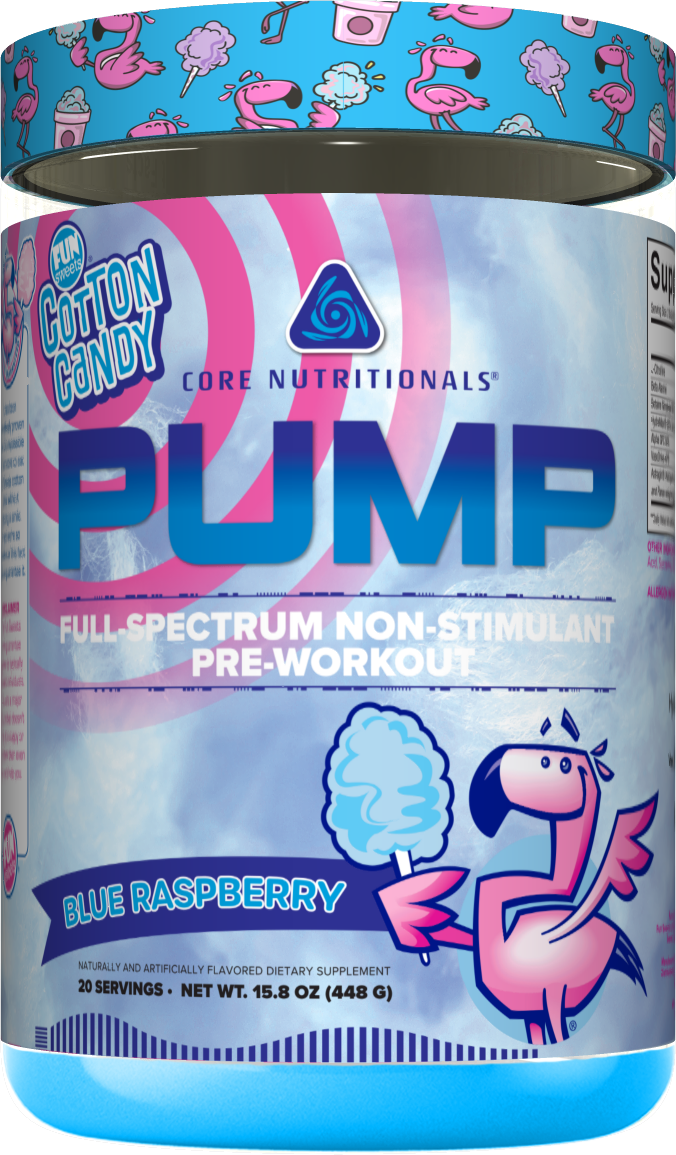
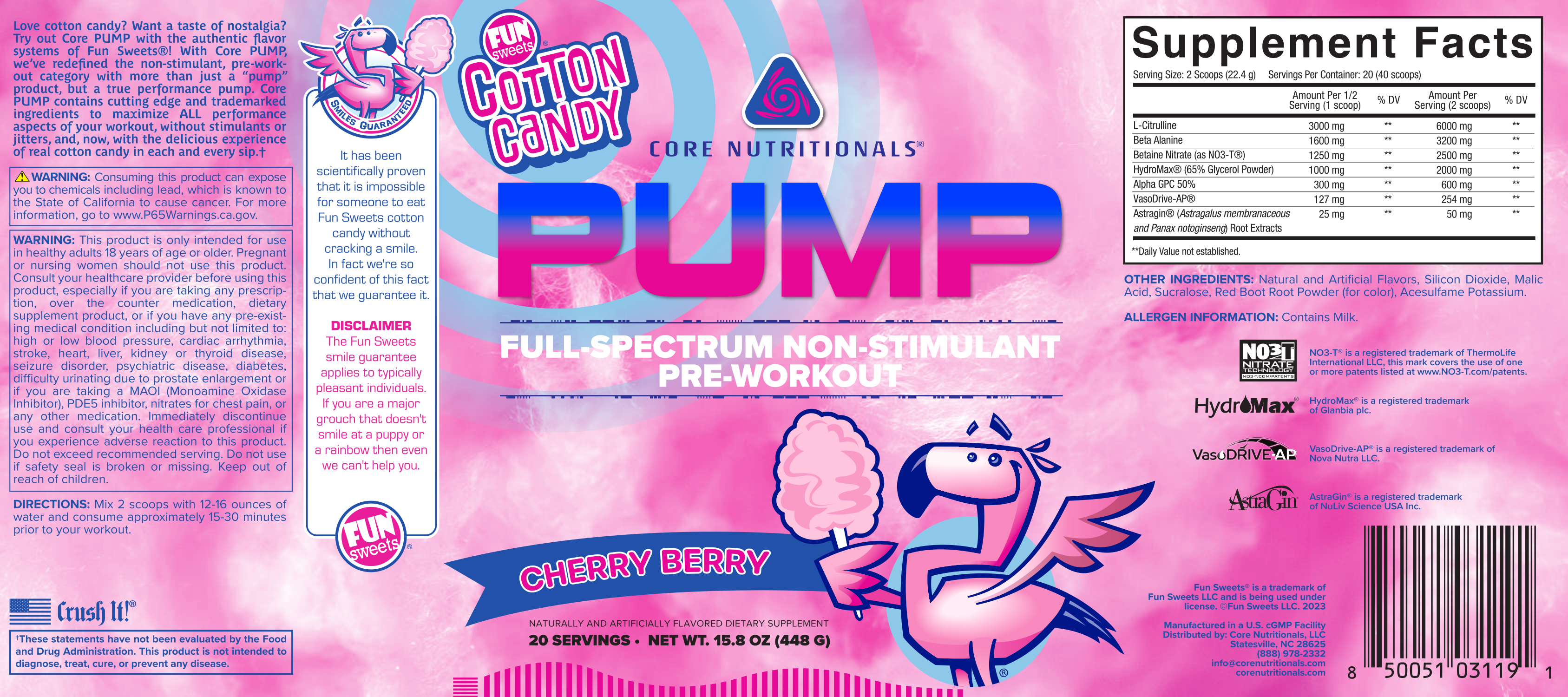


Comments and Discussion (Powered by the PricePlow Forum)